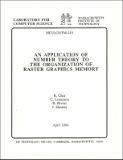| dc.description.abstract | A high-resolution raster-graphics display is usually combined with processing power and a memory organization that facilitates basic graphics operations. For many applications, including interactive text processing, the ability to quickly move or copy small rectangles of pixels is essential. This paper proposes a novel organization of raster-graphics memory that permits all small rectangles to be moved efficiently. The memory organization is based on a doubly periodic assignment of pixels to M memory chips according to a "Fibonacci" lattice. The memory organization guarantees that if a rectilinearly oriented rectangle contains fewer than M/√5 pixels, then all pixels will reside in different memory chips, and thus can be accesses simultaneously. We also define a continuous analogue of the problem which can be posed as, "What is the maximum density of a set of points in the plane such that no two points are contained in the interior of a rectilinearly oriented rectangle of unit area." We show the existence of such a set with density 1/√5, and prove this is optimal by giving a matching upper bound. | en_US |
